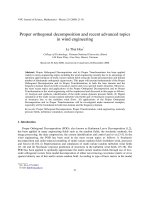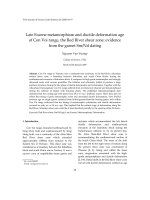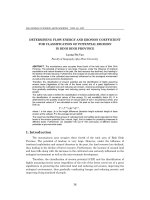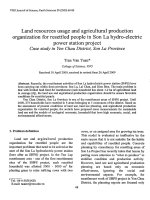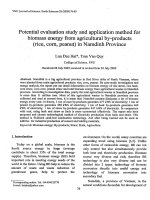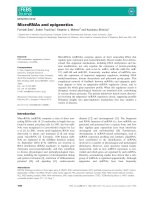Tài liệu Báo cáo " Late Eocene metamorphism and ductile deformation age of Con Voi range, the Red River shear zone: evidence from the garnet Sm/Nd dating" docx
Bạn đang xem bản rút gọn của tài liệu. Xem và tải ngay bản đầy đủ của tài liệu tại đây (1.09 MB, 7 trang )
VNU Journal of Science, Earth Sciences 23 (2007) 69-75
69
Late Eocene metamorphism and ductile deformation age
of Con Voi range, the Red River shear zone: evidence
from the garnet Sm/Nd dating
Nguyen Van Vuong*
College of Science, VNU
Received 26 January 2007
Abstract. Con Voi range in Vietnam was a southeastward continuity of the Red River Ailaoshan
tertiary shear zone, a boundary between Indochina and south China blocks during the
southeastward extrusion of Indochina block. It composed of high grade metamorphic and strongly
deformed rocks with various protoliths. The foliation and schistosity folded to produce a large
antiform structure during the late phase of ductile deformation and exhumation. Together with the
Ailaoshan, Diancangshan, Con Voi range suffered from an intensively sheared and metamorphosed
during the collision of Indian with Eurasian plates. The published radiochronological data
indicated that the cooling age took place from 28 to 17 m.y. (millions years). Those data did not
reflect the timing of peak metamorphic event and associated ductile deformation. New Sm/Nd
isochron age on single garnet extracted from biotite-garnet-silimanite bearing gneiss rock within
Con Voi range evidenced that the timing of metamorphic culmination and ductile deformation
occurred as early as c.a 36 m.y. ago. This implied that the earliest stage of deformation along the
Red River-Ailaoshan shear zone could be at least absorbed partially by the opening of Bac Bo basin.
Keywords: Red River shear; Sm/Nd age; Late Eocene; Metamorphism; Deformation.
1. Introduction
Con Voi range, bounded northeastward by
Song Chay fault and southwestward by Song
Hong fault, was a continuity of the Ailao Shan
Red River shear zone which extended
approximately 1000km from syntaxis to the
Eastern Sea of Vietnam
*
. This shear zone was
considered as a boundary between the Indochina
block and south China one in Tertiary. It was a
narrow zone of amphibolitic-facies gneiss and
_______
*
Tel.: 84-4-8585097.
E-mail:
mylonite which accommodated the left lateral
ductile deformation and southeastward
extrusion of the Indochina block during the
India-Eurasia collision [1, 2]. At present day,
the Ailao Shan-Red River shear zone is
accommodating the southeastward motion of
the South China block. The onset of the shift
from the left to the right sense of motion along
the present shear zone was constrained at
Pliocene [2, 3]. Along and within the shear
zone, magmatism associated with the high-
grade metamorphism and ductile deformation
[2, 4-9]. Partial melts in the Red River shear zone
coeval with ductile deformation yielded an age
Nguyen Van Vuong / VNU Journal of Science, Earth Sciences 23 (2007) 69-75
70
varying from 27 to 22 millions years (m.y.) [5].
Pressure-temperature studies show that left
lateral shear occurred under the amphibolitic
facies conditions which corresponded to the
temperature and pressure varying from 550
o
C
to 780
o
C and from 3kbar to 7kbar respectively
[2]. Systematically radiochronological studies of
the deformed and high metamorphic rocks
inside the shear zone shown that the cooling
age after climax of metamorphism yielded an
age of 28 to 17 m.y. [7, 10-12]. However, zircons
U/Pb dating for leucogranite provided only the
age of melting event associated with high grade
metamorphism, hence the minimum age of
metamorphism, while Ar/Ar data of micas or
amphiboles reflected only cooling ages of the
metamorphism. The technique Th/Pb ion
microprobe dating of monazite inclusions in
garnets by Gilley [13] showed that the timing of
amphibolitic-grade metamorphism and
synchronous left-lateral shearing for the
northern segments of the Ailao Shan Red River
in Yunnan, China occurred between 34 and 21
m.y. Thus ages of metamorphism along the
whole shear zone were dated on the basics of
minerals that had a closure temperature lower
than peak metamorphic temperature and/or not
growth up during the metamorphic event.
The gneissic rocks that exposed along the
Con Voi range contained of frequently reddish
to pink garnets. These minerals were grown up
during the metamorphism and left lateral strain.
This mineral was not only useful for
charactering the metamorphic conditions along
the whole shear zone but also very suitable for
constraining the time of metamorphism. In
order to determine the age of Con Voi range
metamorphic peak and deformed rocks, a single
garnet was selected for Sm/Nd isotope analysis.
2. Tectonic setting and structural characteristics
Con Voi range was the southernmost
segment of the Ailao Shan-Red River shear
zone, an important plate boundary in Cenozoic
in Southeast Asia. In North of Vietnam, it
extended for over 200km from Lao Cai to Viet
Tri in NW-SE direction while its width varied
only from 10 to 20km. Actually, this range is
bounded in the north by the Song Chay fault, in
the south by the Song Hong fault. Along the
Song Hong fault, small sedimentary basins
have been formed during Late Miocene to
Quaternary.
Con Voi range composed of predominantly
paragneissic, partly mylonitic and migmatitic
rocks. Inside the range intercalated several of
mafic and ultramafic bodies or boudinages
which were crystallized and emplaced at 490
m.y. ago [14]. Synkinematic partial melting
produced small leucogranite bodies which were
dated as old as 30-20 m.y. [4, 5]. The peak
metamorphism occurred under the almandine-
amphibolitic facies [2, 10] and probably
granulite facies [15]. The range was affected by
a strained schistosity and foliation delineated
by alternation of rich felsic and dark minerals
layers. Structural observations realized through
the whole range along different cross sections
indicated that the foliation was folded to create
an antiformal structure. The stretching
lineations were marked by the oriented minerals
such as silimanites or elongated feldspars, quartz
or twisted phylosilicates. Despite of the
variation of foliation dip angle, the lineation
was constantly orientated in NW-SE direction
with the plunge varied from 0 to 20
o
. All
kinematic indicators indicated predominantly
sinistral shear sense at various scale from
regional to thin section one.
3. Petrological features of gneiss and
kinematics of ductile deformation
Analysis of thin section of gneiss samples
taken from the Con Voi range evidenced the
existence of two parageneses which developed
during the deformation and metamorphism.
Nguyen Van Vuong / VNU Journal of Science, Earth Sciences 23 (2007) 69-75
71
The first paragenesis, which was typical for
main rocks, was characterized by biotite +
garnet + silimanite + quartz + feldspar that
corresponded to the amphibolitic facies (Fig. 1).
The second one developed mostly within the
pressure shadow of porphyroblast of the first
paragenesis. In some other cases, it was
crystallized within fractures. This paragenesis
was characterized by minerals: muscovite +
biotite + chlorite, a typical assemblage for green
schist facies.
The stretching lineation defined by
silimanite and porphyroclast of feldspars or
deformed quartz of the first paragenesis
oriented in the same direction of extensional
fractures in which the minerals of second
paragenesis grown up. In many cases,
silimanites and garnets suffered from a brittle
deformation to produce boudinage structure.
The space between boudinages was also filled
up by the muscovite, biotite and chlorite of the
second assemblage of minerals.
Stretching lineation defined by minerals of
two parageneses had the same direction. The
different criteria of shears recorded by the
minerals of the first paragenesis indicated a left
lateral motion. The secondary minerals
crystallized within the pressure shadow of the
main minerals of the first paragenesis also
indicated a sinistral shears. The rotation of
garnet in some cases was also compatible with
the left lateral shear. Consequently, the similarity
of the shear sense recorded by two parageneses,
observed at different scales from thin section to
outcrops implied a retrograde evolution of
metamorphism and ductile deformation.
4. Samples description
To constrain the age of highly ductile
deformation and metamorphism of the gneissic
rocks along the Con Voi range, sample
VNSH14-2 was selected for garnet Sm/Nd
dating. It was taken at a quarry located about
30 km on the right side of the road N70 from
Yen Bai to Lao Cai. The coordinates of the
sample were 21° 47’ 54.3” and 104° 54’ 45.1” in
WGS-84 coordinate system (see Fig. 2 for sample
location). Two kinds of rocks were
Fig. 1. Thin section photograph illustrated parageneses of paragneissic rocks from Con Voi range.
Nguyen Van Vuong / VNU Journal of Science, Earth Sciences 23 (2007) 69-75
72
observed in this outcrop. A folded ultramafic
body with the axial plan was parallel to the
foliation of the gneiss country rocks. The
sample VNSH14-2 was characterized by a
mineral assemblage composing of biotite,
garnet (almandine), silimanite, quartz, feldspar
while apatite and zircon dominated in
accessory minerals and by a schistosity coupled
with lineation fabric.
5. Analytical method
5.1. Single mineral separation
A fresh hand sample of about 1.5 kg was
cleaned, crushed and pulverized to 250
micrometer. Light minerals such quartz,
feldspars, biotite were separated from heavy
one like garnet, silimanite by Whilfley vibrate
table. The heavy minerals then were put into
Franz dynamic magnetic separator for selection
garnets. Single mineral of garnets then was
carefully observed and picked under binocular.
Only very high transparency free inclusion as
well as cracks and euhedral garnets were
selected to digest with chemical agents.
Feldspars fragments were also selected to
analyze. Whole rock powder was obtained by
crushing in ball grinder. The elimination of
dusts, carbonate and sulfur film were made
with HCl and HNO3 and ultrasonic tank within
one hour.
Fig. 2. Petro-structural sketch map of Con Voi range and sample location.
1- Late Eocene-Miocene metamorphic rocks of Con Voi range; 2- Triassic to Miocene metamorphic rocks; 3- Unknown age
metamorphic rocks; 4- PZ weak metamorphic rocks; 5- Granites; 6- Ultramafic and mafic rocks; 7- Early-Middle Triassic
terrigenous clastic and carbonate rocks; 8- Late Triassic coal bearing sedimentary rocks; 9- Jurassic-Cretaceous detrial
sedimentary rocks; 10- Jurassic-Cretaceous volcanic rocks; 11- Neogene coarse grained size sediments; 12- Quaternary
sediments; 13- Oligocene-Miocene sinistral shear zone; 14- Faults; 15- Sample location.
Nguyen Van Vuong / VNU Journal of Science, Earth Sciences 23 (2007) 69-75
73
5.2. Sm and Nd separation
Garnet, whole-rock (WR) powders,
feldspars were spiked with mixed
149
Sm-
150
Nd
tracer and dissolved in Teflon vial using an HF-
HNO
3
-HCLO
4
mixture and 6N HCl until
complete material dissolution. Column
procedures used cationic AG-50W-X8 (200-400
mesh) resin in order to separate rare earth
elements (REE), followed by Sm and Nd
separation using anionic polyteflon HDEHP
LN-B50-A (100-200µm) resin. Nd and Sm were
separated from the solution by 0.18 and 0.5N
HCl respectively.
5.3. Isotopic ratio measurement
143
Nd/
144
Nd and
147
Sm/
144
Nd ratios were
measured on Finigan 262 thermal ionization
multi collectors mass spectrometer under
standard operation at Goettingen University.
Sm and Nd were loaded as phosphate on pre-
conditioned Re filaments and measurements
were performed in a Re double filament
configuration. La Jolla standard was performed
during the course of measurement. The error of
standard was not in excess of 0.003% and 0.05%
for
143
Nd/
144
Nd and
147
Sm/
144
Nd respectively. All
measured rations were normalized to
146
Nd/
144
Nd =0.7219. Correction for blank was
insignificant for Nd isotopic compositions and
generally insignificant for Sm/Nd ratios.
Neodymium model ages (TDM) were calculated
following the depleted mantle model of De
Paolo [16].
The analytical results were reduced and
treated by using Ludwig’s program ISOPLOT
2.49.
6. Analytical results
The isotopic ratio and concentration of Sm
and Nd are given in Table 1. The isochon age of
garnet and whole rock was calculated and
displayed in Fig. 3. In this diagram, the isotopic
ratio of plagioclase was kicked out due to the
very low concentration of Sm.
7. Discussion and conclusion
The peak metamorphism of the Con Voi
range occurred at around 690
o
C and 0.65GPa
[10] of amphibolitic facies. This P-T calculation
was performed on the minerals corresponding
to the first paragenesis observed in this study.
In fact, no minerals, except for the zircon, had
the closure temperature higher than the
temperature at which the metamorphism of
Con Voi range culminated. Although the zircon
had very high closure temperature but the
direct link to the metamorphism and ductile
deformation lacked. Therefore, the interpretation
of the zircon age for metamorphism and
interfoliation leucogranite strongly depended
on the structural relation of the samples and
country rocks and also on the thermal history in
which the rock itself experienced. All other
radioactive dating methods applied for any
mineral extracted from the first paragenesis
indicated only the cooling age after culmination
of the metamorphism and associated ductile
deformation. Hence, timing of peak
metamorphism hardly deduced.
Together with biotite, garnet was always
used to calculate the P-T condition of
metamorphism and ductile deformation.
Therefore such result often reflected its
culmination. However, due to the low closure
temperature of biotite in comparison with
garnet and metamorphic peak temperature, the
age obtained on biotite was effectively younger
than the real age of metamorphism. Consequently
the timing of thermotectonic event could not be
determined on biotite or other micas except
mineral having the closure temperature as high
as the one at which the peak metamorphism
occurred. In case of metamorphic and sheared
Nguyen Van Vuong / VNU Journal of Science, Earth Sciences 23 (2007) 69-75
74
Table 1. Isotope ratio and concentration of Nd, Sm of analyzed samples
Minerals Sm (ppm) Nd (ppm)
147
Sm/
144
Nd 2SE Error (abs)
143
Nd/
144
Nd 2SE Error (abs)
Garnet 3.247 5.540 0.354256260 0.001771281 0.511859746 0.000005288
WR 8.043 46.340 0.104908211 0.000524541 0.511801401 0.000007964
Plagioclase 0.424 2.647 0.096874579 0.000484373 0.511801152 0.000008356
VNS H - 14 - 2
WR
Garnet
0.51177
0.51179
0.51181
0.51183
0.51185
0.51187
0.05 0.15 0.25 0.35 0.45
147
Sm/
144
Nd
143
Nd/
144
Nd
Data-point error ellipses are 2
σ
Model 1 Solution on 2 points
Age = 35.8 ± 5.7 Ma
Initial 143/144=0.511777 ± 0.000011
MSWD = 0.000, Probability = 1.000
Fig. 3. Mineral isochron computed based on two point garnet and WR.
paragneissic rocks of Con Voi range, only
garnet was suitable to obtain the age we
expected. It was accepted that the closure
temperature of garnet for Sm/Nd isotopic
system was over 680
o
C event up to 750
o
C [17].
Therefore, the age of 35.6 m.y. obtained on
garnet crystal in this work reflected timing of
cooling down to under the garnet closure
temperature for Sm/Nd isotopic system. The
peak temperature of metamorphism and
ductile deformation of paragneiss coincided
with garnet closure temperature so that the age
of 35.6 m.y. recorded timing of metamorphic
culmination. This new result, together with
previous data [2, 6, 7, 11-13] suggested that the
metamorphism and ductile deformation of Con
Voi range began as early as 36 m.y. ago. Taking
in to account the late Miocene-Oligocene basal
strata in the Bac Bo basin, this result also
revealed the temporal and could be genetic
links between the earliest stage of deformation
along the Red River Ailao Shan shear zone with
the opening of Bac Bo basin.
The initial ratio 143/144Nd = 0.511777 and
εNd = -15.44 suggested that the main components
of those metamorphic rocks originated from the
sedimentary crust with out or less
contamination with the mantle materials. The
model age TDM=1880 m.y. calculated from the
isochron suggested that the provenance of
metamorphic rocks of Con Voi range might
derive from the Proterozoic sedimentary rocks.
Acknowledgements
The author is indebted Prof. Bent Hansen
and Dr. Klaus Wemmer who gave all favorable
conditions to access the analytical facilities at
GZG of Goettingen University. This work
Nguyen Van Vuong / VNU Journal of Science, Earth Sciences 23 (2007) 69-75
75
would not be done without their valuable
support.
This paper is completed with the support of
the Vietnam Fundamental Research Program in
Natural Sciences, the author would like to
thank the Council of Natural Sciences.
References
[1] P. Tapponnier et al., The Ailao Shan/Red River
metamorphic belt: Tertiary left lateral shear
between Indochina and South China, Nature 343
(1990) 431.
[2] P.H. Leloup et al., The Ailao Shan-Red River
shear zone (Yunnan China), Tertiary transform
boundary of Indochina, Tectonophysics 251 (1995) 3.
[3] C. Rangin et al., The Red River fault system in
the Tonkin Gulf, Vietnam, Tectonohysics 243
(1995) 209.
[4] U. Schaerer et al., Intraplate tectonics in Asia:
Aprecise age for large-scale Miocene movement
along the Ailao Shan-Red River shear zone,
China, Earth and Planetary Science Letters 97 (1990) 65.
[5] U. Schaerer, L.S. Zhang, and P. Tapponnier,
Duration of strike-slip movements in large
shear zones: the Red River belt, China, Earth and
Planetary Science Letters, 126 (1994) 379.
[6] T.M. Harrison et al., An Early Miocene
transition in deformation regime within the Red
River Fault zone, Yunnan, and its significance
for Indo-Asian tectonics, Journal of Geophysical
Research 97/B5 (1992) 7159.
[7] T.M. Harrison et al., Diachronous initiation of
transtension along the Ailao Shan-Red River
shear zone, Yunnan and Vietnam, in The tectonic
evolution of Asia Ed.: A. Yin and T.M. Harrison
(1996) 208.
[8] P.H. Leloup, J.R. Kienast, High temperature
metamorphism in a major strike-slip shear zone:
the Ailao Shan-Red River (P.R.C.), Earth and
Planetary Science Letters 118 (1993) 213.
[9] S.L. Chung et al., Intraplate extension prior to
continental extrusion along the Ailao Shan-Red
River shear zone, Geology 4/25 (1997) 311.
[10] T.N. Nam, M. Toriumi, T. Itaya, P-T-t paths and
post-metamorphic exhumation of the Day Nui
Con Voi shear zone in Vietnam, Tectonophysics
290 (1998) 299.
[11] P.L. Wang et al., Thermochronological evidence
for the movement of the Ailao Shan-Red River
shear zone; a perspective from Vietnam, Geology
10/26 (1998) 887.
[12] P.L. Wang et al., Onset of the movement along
the Ailao Shan-Red River shear zone: Constraint
from
40
Ar/
39
Ar dating results for Nam Dinh
Area, northern Vietnam, Journal of Asian Earth
Sciences 18 (2000) 85.
[13] L.D. Gilley et al., Direct dating of left-lateral
deformation along the Red River shear zone,
China and Vietnam, Journal of Geophys. Res.
108/B2 (2003) 2127.
[14] N.V. Vuong et al., Sm/Nd mineral isochron age
of ultramafic rock within the tertiary Red River
shear zone and its geodynamic signification,
Journal of Earth Sciences 2/27 (2005) 97 (in
Vietnamese).
[15] T.T. Thang, T.T. Anh, New mineralogical
evidence of granulite facies in Red River
metamorphic belt, Journal of Earth Sciences 4/22
(2000) 410 (in Vietnamese).
[16] D.J. De Paolo, Neodymium isotopes in the
Colorado Front Range and implications for
crust formation and mantle evolution in the
Proterozoic, Nature 291 (1981) 193.
[17] K. Mezger, E.J. Essene, A.N. Halliday, Closure
temperature of the Sm-Nd system in
metamorphic garnets, Earth and Planetary Science
Letters 113 (1992) 397.

